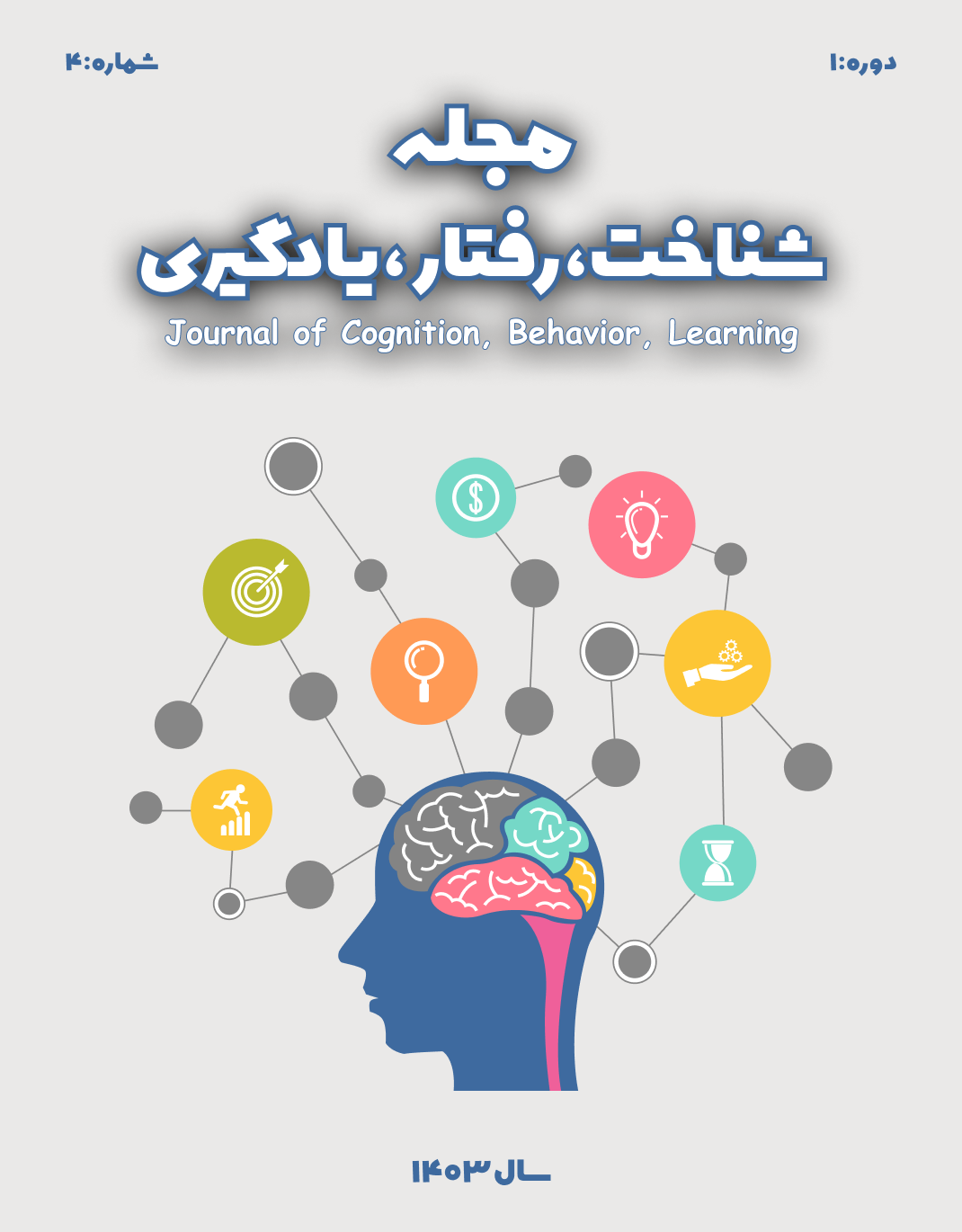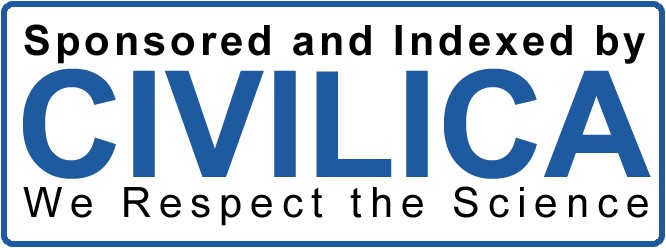اثربخشی الگوی بومی خانواده شاد بر اساس روانشناسی مثبت نگر بر صمیمیت والدین
کلمات کلیدی:
الگوي بومي خانواده شاد, روانشناسی مثبت نگر, صمیمیت زوجینچکیده
پژوهش حاضر باهدف اثربخشی الگوی بومی خانواده شاد بر اساس روانشناسی مثبت نگر بر صمیمیت والدین انجام شد. روش پژوهش نیمه آزمایشی از نوع طرح پیشآزمون-پسآزمون با گروه کنترل بود. جامعه آماری پژوهش شامل کلیه زوجین مراجعهکننده به کلینیکها و مطلبهای روانشناسان در شهر زنجان در سال 1403، تشکیل دادند که با روش نمونهگیری در دسترس، تعداد 40 نفر انتخاب و بهطور تصادفی در گروه آزمایش (20 نفر) و کنترل (20 نفر) تقسیم شدند. ابزار گردآوری دادهها در این بخش شامل پرسشنامه صمیمیت زوجین (ووندن بروک و هانس برتمن (1995) و پرسشنامه شادکامی آکسفورد (آرجیل و همکاران، 1989) میباشد. برای تحلیل دادهها از آمار توصیفی و استنباطی (تحلیل کوواریانس) استفاده گردید. نتایج حاصل از تحلیل کوواریانس بیانگر تأیید تأثیر آموزش الگوی بومی خانواده شاد بر صمیمیت زوجین بود. بنابراین، نتایج این پژوهش تأیید میکند که الگوی بومی خانواده شاد مبتنی بر روانشناسی مثبت نگر بهطور معناداری بر صمیمیت والدین تأثیرگذار است. این یافتهها میتواند بهعنوان مبنایی برای طراحی و اجرای برنامههای آموزشی و مداخلهای در جهت ارتقاء روابط زوجین و بهبود کیفیت زندگی خانوادگی مورداستفاده قرار گیرد.
دانلودها
مراجع
Agarwal, R., & Sahai, A. (2024). Exploring the Influence of Family Quality of Life on Intimacy and Marital Attitudes among Indian Young Adults. International Journal of Interdisciplinary Approaches in Psychology, 2(4), 1185-1201. https://psychopediajournals.com/index.php/ijiap/article/view/254
Ahmadi, S., Ahmadi, S., & Kheirandish, A. (2016). The effectiveness of yoga practice on positive psychology constructs: meaning in life, gratitude and marital intimacy. Int. J. Psychol, 10, 105-126. https://www.sid.ir/FileServer/JE/5062520160205.pdf
Antoine, P., Andreotti, E., & Congard, A. (2020). Positive psychology intervention for couples: A ضئضئ study. Stress and Health, 36(2), 179-190. https://doi.org/10.1002/smi.2925
Bergeron, S., Vaillancourt-Morel, M. P., Péloquin, K., & Rosen, N. O. (2024). Intimacy Promotes Couples' Sexual Well-Being on a Daily Basis and Over One Year: The Role of Positive Sexual Cues. Archives of Sexual Behavior, 1-13. https://doi.org/10.1007/s10508-024-02912-7
Bossio, J. A., Higano, C. S., & Brotto, L. A. (2021). Preliminary Development of a Mindfulness-Based Group Therapy to Expand Couples' Sexual Intimacy after Prostate Cancer: A Mixed Methods Approach. Sexual Medicine, 9(2), 100310. https://doi.org/10.1016/j.esxm.2020.100310
Carasso, E., & Dikla, S. K. (2024). Marital strain and emotional intimacy in midlife couples: The moderating role of empathy. Personal Relationships. https://doi.org/10.1111/pere.12559
Chen, J. J. A. U. W. Q. L., Li, H. P., Zhang, T., Zhang, S. S., & Zhou, M. K. (2021). Family resilience, perceived social support, and individual resilience in cancer couples: analysis using the actor-partner interdependence mediation model. European Journal of Oncology Nursing, 52, 101932. https://doi.org/10.1016/j.ejon.2021.101932
Cullen, K., & Fergus, K. (2021). Acceptability of an online relational intimacy and sexual enhancement (iRISE) intervention after breast cancer. Journal of marital and family therapy, 47(2), 515-532. https://doi.org/10.1111/jmft.12516
D'Ottone, I. C., Pfund, G. N., & Hill, P. L. (2024). Purposeful Partners: Potential Relationship Quality and Sense of Purpose. International Journal of Applied Positive Psychology, 9(2), 489-510. https://doi.org/10.1007/s41042-023-00136-z
Du, X., Chaiviboontham, S., & Sumdaengrit, B. (2024). The experiences of Chinese colorectal cancer survivors in marital intimacy after ostomy creation: A qualitative study. Belitung Nursing Journal, 10(2), 222. https://doi.org/10.33546/bnj.3212
Falakdin, Z., & Hajizadeh Meymandi, M. (2022). The role of women in family happiness: A qualitative study in the city of Yazd. Journal of Applied Sociology, 33(4), 122EP - 195. https://ssoss.ui.ac.ir/article_26325_en.html
Haroun Rashidi, H., & Kianianmehr, Z. (2019). The effect of positive-oriented couple therapy on marital purity and sexual satisfaction of female students. Pathology, Counseling and Enrichment of Family, 1(9), 125EP - 138. https://grow2serve.com/wp-content/uploads/married-in-mission.pdf
Hatch, S. G., Guttman, S., Rothman, K., Le, Y., Bucan, N. R., & Doss, B. D. (2024). Does Web-Based Relationship Education Improve Sexual Intimacy? Initial Examination, Replication, and Exploration of Moderation in a Low-Income Sample. Archives of Sexual Behavior, 1-8. https://doi.org/10.1007/s10508-024-02876-8
Heaphy, B., & Hodgson, J. (2021). Public sex, private intimacy and sexual exclusivity in men's formalized same-sex relationships. Sexualities, 13634607211028108. https://doi.org/10.1177/13634607211028108
Jones, S., Albuquerque, S., & Pascoal, P. M. (2024). Grief and Sexual Intimacy: Exploring Therapists' Views of Bereaved Clients. International Journal of Sexual Health, 1-13. https://doi.org/10.1080/19317611.2024.2354815
Khamis, N., & Ayuso, L. (2021). Female Breadwinner: More Egalitarian Couples? An International Comparison. Journal of Family and Economic Issues, 1-12. https://doi.org/10.1007/s10834-021-09784-2
Khan, M., & Ebrahim, S. (2024). The Marital Sexual Experiences of South African Muslim Wives of Indian Descent: Interpretative Phenomenological Analysis. Journal for the Study of Religion, 37(1), 1-24. https://doi.org/10.17159/2413-3027/2024/v37n1a5
Lyvers, M., Pickett, L., Needham, K., & Thorberg, F. A. (2021). Alexithymia, Fear of Intimacy, and Relationship Satisfaction. Journal of Family Issues, 0192513X211010206. https://doi.org/10.1177/0192513X211010206
Mohammadi, M. (2023). The role of family cohesion and couple communication patterns in predicting happiness in married female nurses in Kermanshah. Journal of New Strategies in Psychology and Educational Sciences, 20(11), 24-17. https://brill.com/view/journals/haww/22/3-4/article-p436_10.xml
Nakhostin, N., Musazadeh, T., & Kiamarsi, A. (2022). The Effectiveness of an Emotion-Oriented Approach on Intimacy, Communication Skills, and Feelings of Worth in Incompatible Couples. Razi Journal of Medical Sciences, 29(7), 33-42. https://www.sid.ir/fileserver/jf/52414010704.pdf
Navabinejad, S., Rostami, M., & Parsakia, K. (2024). Influences of Family Structure and Intimacy on Emotional Divorce: A Cross-Sectional Analysis. JPRFC, 23-30. https://doi.org/10.61838/kman.jprfc.2.1.5
Panahifar, S. (2021). Comparing the effectiveness of schema-based, emotion-focused, and acceptance and commitment-based couple therapy on intimacy functions, reducing marital stress, and the desire for divorce in families in the system. Master's thesis, Lorestan University. https://npwjm.ajaums.ac.ir/article-1-880-fa.html
Parsakia, K., Farzad, V., & Rostami, M. (2023). The Mediating Role of Attachment Styles in the Relationship Between Marital Intimacy and Self-Differentiation in Couples. Aftj, 4(1), 589-607. https://doi.org/10.61838/kman.aftj.4.1.29
Poursaeid, S. R., Jaberi, S., Etemadi, O., & Ahmadi, S. A. (2023). Investigating the relationship between communication skills and marital intimacy. Journal of Women and Family Studies, 11(1), 128-155. http://cbs.ui.ac.ir/article_20749_en.html
Price, A. A., Leavitt, C. E., Gibby, A. L., & Holmes, E. K. (2024). "What Do You Think of Me?": How Externalized Self-Perception and Sense of Self are Associated with Emotional Intimacy. Contemporary Family Therapy, 46(1), 52-62. https://doi.org/10.1007/s10591-023-09673-w
Reza, A. H., & Leyli, B. E. (2016). Investigating the role of organizational happiness inteachers' occupational burnout. Journal of Fundamental and Applied Sciences, 8(2S), 1444-1465. https://doi.org/10.4314/jfas.v8i2s.66
Saeidiyousefi, M., Mohammadian, F., & Nademi, A. (2023). Comparison of the effectiveness of emotion-focused couple therapy and schema-focused couple therapy on partner acceptance in couples with marital differences. Rooyesh-e-Ravanshenasi Journal, 12(4), 64-55. https://journals.sbmu.ac.ir/ch/index.php/ch/article/download/31198/20450/125638
Seligman, M. E. (2003). Fundamental assumptions (Vol. 16). https://core.ac.uk/download/pdf/49139.pdf
Seligman, M. E., Steen, T. A., Park, N., & Peterson, C. (2005). Positive psychology progress: empirical validation of interventions. American psychologist, 60(5), 410. https://doi.org/10.1037/0003-066X.60.5.410
Singla, R. (2024). Doing Intimacy Differently-An Emerging Trend: Living Apart Together Transnationally (LATT) Couples. https://doi.org/10.1007/978-3-031-52205-5_1
Sodani, M., Shogaeyan, M., Khojastamhr, R., & Shiralinia, K. H. (2017). The Effectiveness of Collaborative Couple Therapy on Communication Patterns and Intimacy of Couples Referring to Counseling Centers of Behbahan, Iran. Armaghane Danesh, 22(4), 499-514. http://armaghanj.yums.ac.ir/browse.php?a_id=1548&sid=1&slc_lang=en
Surijah, E. A., Prasad, G. H., & Saraswati, M. R. A. (2021). Couple resilience predicted marital satisfaction but not well-being and health for married couples in Bali, Indonesia. Psikohumaniora: Jurnal Penelitian Psikologi, 6(1), 13-32. https://doi.org/10.21580/pjpp.v6i1.6520
Tarkeshdooz, Z., Jenaabadi, H., & Tamini, B. K. (2022). The effectiveness of self-regulated couple therapy on intimacy and marital adjustment of couples with marital problems. International Journal of Applied Behavioral Sciences, 9(1), 38-45. https://journals.sbmu.ac.ir/ijabs/article/view/35992
Yemiscigil, A., Yılmaz, M. S., & Lee, M. T. (2023). How to find your purpose. In.
Ying, J., & Parsakia, K. (2024). Behavioral Activation Therapy: Boosting Happiness and Creativity Among College Students. KMAN Counseling & Psychology Nexus, 2(2), 57-65. https://doi.org/10.61838/kman.psynexus.2.2.9
Zare Zardini, F., Hashemi, Z., & Abdollahi, A. (2022). The mediating role of basic psychological needs in the relationship between family functioning and happiness in undergraduate students residing in Alzahra University dormitory. Journal of Applied Psychological Research, 13(1), 63-43. https://www.sid.ir/fileserver/je/341-312564-x-1436725.pdf
دانلود
چاپ شده
ارسال
بازنگری
پذیرش
شماره
نوع مقاله
مجوز
حق نشر 2025 بهروز شادمان , رحیم حمیدی پور, حسن حیدری , میر سعید جعفری , سید علی آل یاسین (نویسنده)

این پروژه تحت مجوز بین المللی Creative Commons Attribution-NonCommercial 4.0 می باشد.





